Content
- 1 Popular varieties of forsythia with photographs and the birthplace of their growth
- 2 Features of growing forsythia in the open field
- 3 Outdoor care for forsythia
- 4 Methods for breeding forsythia
- 5 Pests, bush diseases and how to deal with them
- 6 Pruning bushes
- 7 Preparing for the winter forsythia
- 8 Landscaping: garden ideas
- 9 Conditions for planting forsythia in the open field
- 10 Timing of planting forsythia in the ground
- 11 Planting forsythia in open ground
- 12 Caring for forsythia after planting in the open field
- 13 Reproduction of forsythia in the open field
- 14 How to choose the right variety
- 15 What should be the planting material
- 16 How to choose a landing site
- 17 What should be the soil
- 18 How to plant
- 19 How to care
- 20 How to water forsythia
- 21 How to feed
- 22 How to do pruning correctly
- 23 Infections
- 24 How to propagate
- 25 Description
- 26 Vegetative propagation
- 27 How and when to sow seeds
- 28 Planting and caring for seedlings
- 29 Types of forsythia
- 30 Landscape application
- 31 Proper care for forsythia (video)
Forsythia (or Forsythia, named after the English botanist Forsythe) is an extremely unusual plant. It belongs to the genus of deciduous ornamental shrubs, and, moreover, is considered one of the earliest, primrose flowers. This means that during early spring, against the gray background of still unawakened nature, bare trees, forsythia bushes are already beginning to bloom and brighten the landscape with their bright golden bell-shaped flowers.
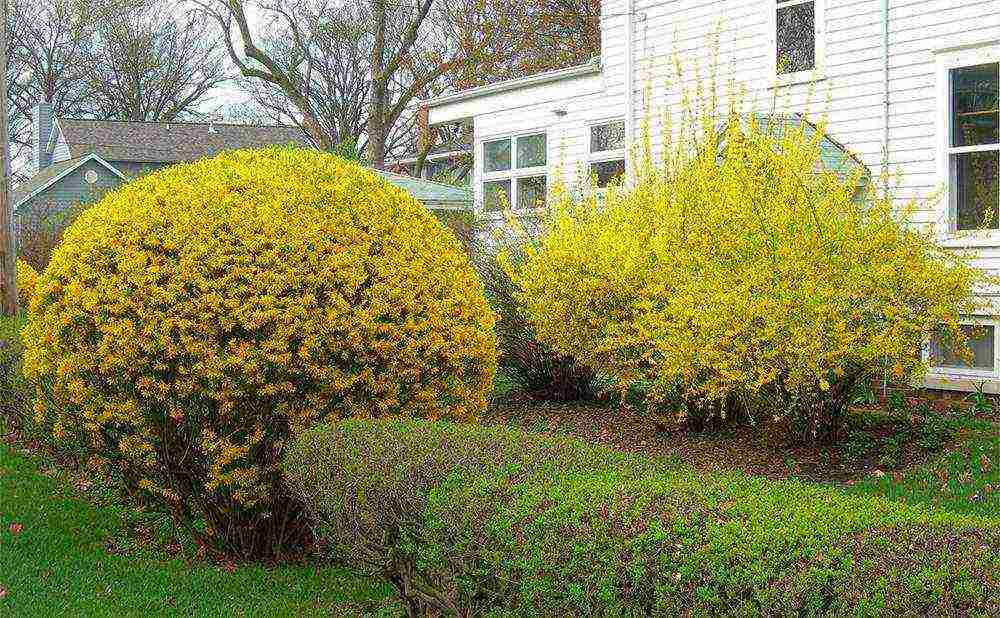
Popular varieties of forsythia with photographs and the birthplace of their growth
It is popularly believed that there are about 6 varieties of forsythia in total, of which 5 are grown in the middle lane.
Forsythia European
It was first discovered in the Southeastern part of Europe, specifically on the slopes of the Balkan Peninsula.
This shrub is not very tall, about 2 m high (12 years -3.5 m). Leaves up to 7 cm long. The flowers are golden yellow, have a weakly pronounced bell shape.
Forsythia Giralda
Homeland: northern part of China.
Special characteristics: slightly curved branches, leaves up to 10 cm long, flowers of light yellow color, large, with slightly twisted openwork petals. Compared to European forsythia, this plant is more sensitive to low temperatures.
Forsythia Ovate
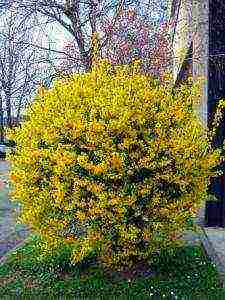
Photo. Forsythia ovoid
Comes from the deciduous forests of the Korean Peninsula. It is considered the most winter-hardy and drought-resistant, and therefore extremely popular in Central Russia, since it is possible to grow it without shelter.
Varieties and their features:
- "Melisa" (dwarf and very compact crown)
- "Tetragold" (dark yellow flowers)
- "Spring Glory" (longest flowering period, color varies from yellow to crimson depending on flowering time)
Forsythia Hanging
The wild hanging forsythia is still found in the North and Central regions of China.
Arcuate branches drooping. The flowers are golden yellow, small, growing in bunches along the shoots.
Further, decorative plant species with the most significant features of each:
- variegated (leaves with a golden tint);
- purple-stemmed;
- deceptive;
- Fortune (dark yellow flowers);
- Siebold;
Forsythia the Greenest
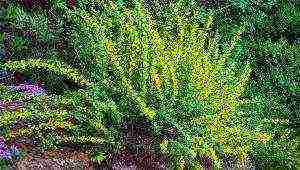
Photo. Forsythia is greenest
Homeland of growth: East China. Wild forsythia loves mountain slopes and covers them with whole thickets.
Features: very dark, long (up to 15 cm long), serrated, oblong leaves. The flowers can also have a greenish tint.
Forsion Medium / Intermediate
Intermediate forsythia is a hybrid between dark green and overhanging. It is characterized by a wide selection of different decorative shapes. Here are some of them:
- "Fiesta"
- "Beatrix Farrand"
- "Lindwood" (formed as a standard plant)
- "Variegata"
It should be noted that there is one more species - Snow Forzition, or Abeliophyllum. Unfortunately, this species is endangered, listed in the Red Book and is extremely rare.
Features of growing forsythia in the open field
It is known that forsythia is extremely popular in landscaping European cities. It can often be found on the streets and in parks. This is due not only to the attractive type of plant, but also to the fact that it is unpretentious and undemanding. Caring for forsythia does not require special gardening skills and will not cause trouble even for the inexperienced.
Planting season
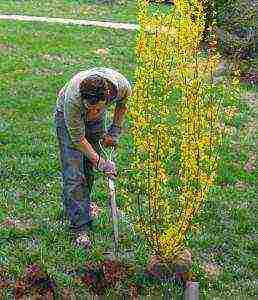
Forsythia is planted in spring or early autumn before frost.
Planting is done either in early autumn, before the onset of frost, or in spring.
Reference: Remember to mulch the soil with dry leaves, especially when planting in early fall.
Planting forsythia yourself
The soil requirements are as follows: light loam or calcareous, slightly alkaline dry soils.
Reference: The site must be protected from the wind!
The planting scheme is as follows: 0.7 - 1.5 m between plants in a group planting, the hole for each plant should be 50x50x60 cm in volume.
Tamping the pit before planting the plant:
- 12 cm of drainage (crushed stone, broken brick);
- 10 cm of sand;
- a mixture of leafy soil and peat in a 2: 1 ratio;
- 200 grams of wood ash;
After planting, the land must be compacted without fail.
Outdoor care for forsythia
The plant is unpretentious, caring for it does not require special care. It should only be noted that forsythia is light-requiring, therefore, constantly shaded planting areas are undesirable for it. Watering is moderate; in dry weather, the plant requires no more than 10-12 liters of water per month.
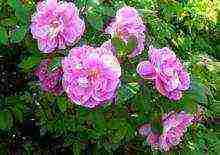
Canadian
roses teresa bagnet
quite interesting and unusual, will interest any gardener.
Rose Lovely Green has an unusual green color, more details here.
Fertilization three times per season:
- For the first time with rotted manure along the near-trunk circle (not close) with abundant watering (period: early spring);
- Then a full-fledged mineral fertilizer at the rate of 60-70 grams per 1 m² (April);
- Top dressing "Kemira-universal" 100-120 grams per 1 m² (period after flowering);
Methods for breeding forsythia
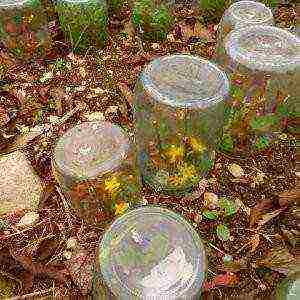
The most successful breeding method for forsythia is cuttings
There are two ways to reproduce forsythia: seed and vegetative (i.e. root suckers, dividing the bush and cuttings).
In gardening, vegetative methods are, of course, popular.
If you prefer to grow forsythia by cuttings, then:
Cuttings are cut to a length of about 15 cm, preferably in June. Further, the lower leaves must be cut off, the branch itself is treated with a rooting stimulator (root, epin, heteroauxin), after which it can be planted. Older and lignified cuttings can be planted in early autumn, before the frost begins, only it is necessary to form a cover of dry leaves so that the plant overwinters and takes root.
If you decide to grow forsythia by layering, then:
The young shoot should be bent to the ground and secured. Having previously cut the bark, fill it with fertile soil on top. Thus, the shoot will take root very soon and a new plant will form. The old branch can be cut after a year.
Forsythia seeds reproduce poorly, so this method is not popular among gardeners.
Pests, bush diseases and how to deal with them
Forsythia undergoes bacteriosis and moniliosis, nematodes. In the first case, the plant cannot be helped in any way, and it can only be dug up by the roots and thrown away.
Miniliosis Is a fungal disease characterized by brown spots on the leaves. Not to be confused with simple wilting, since such remedies as Fundazol or Zeneb (solution of 2-5%) save from wilting, while miniliosis can only be cured by cutting out all damaged tissue. Under the harmful effects of nematodes, the soil under the plant is disinfected with "Carbation".
Pruning bushes
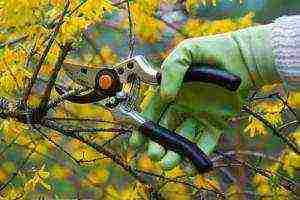
As usual, forsythia is pruned to remove dried and frozen branches
Forsythia undergoes only sanitary pruning, i.e. does not have special requirements. Dried branches are cut off, in adult shrubs - frozen ends of branches. Sometimes, after the flowering period, all forsythia branches are shortened by one third, if desired, with the addition of a spherical or cupped shape to the bush. But such radical methods are used, as a rule, to "rejuvenate" the bush, that is, in order to enable new shoots to germinate. This procedure should be done no more than once every 4 years.
Preparing for the winter forsythia
For young plants, a cover of spruce branches should be prepared in advance. Otherwise, the branches of the bush are bent to the ground and, if possible, are strengthened in this position. The trunk and the free circle are covered with dry branches and leaves, from above the entire bush is covered with spruce branches. Please note: as mentioned above, some types of plants, such as Forsythia ovate, are able to overwinter without any shelter.
Landscaping: garden ideas
It has long been found that forsythia looks best against the background of dark green conifers, so spruce, thuja, and juniper usually go as companions. Forsythia itself is most often planted as a specimen (i.e. a single plant), or as part of mixborders (flower beds of free combinations). Hanging forsythia looks very impressive on the trellises of buildings, it is used for decorating slopes, in hedges.
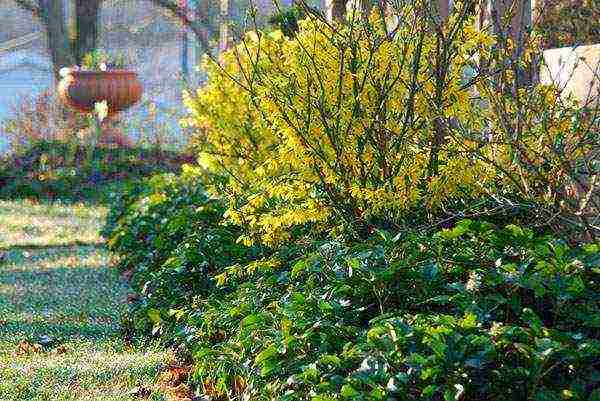 Blooming forsythia, strewn with hundreds of bright yellow flowers, is impossible to miss! If the summer resident wants to be decorated with forsythia every spring, planting and care in the open field are key stages on the path to success.
Blooming forsythia, strewn with hundreds of bright yellow flowers, is impossible to miss! If the summer resident wants to be decorated with forsythia every spring, planting and care in the open field are key stages on the path to success.
Perennial shrubs, one of the first to break the monochrome of early spring, came to Europe from Asia and were named after the botanist who brought the first seedlings to the Old World. Today forsythia is the most popular type for landscaping and creating hedges.
How and when to organize planting and caring for forsythia in the open field at their summer cottage? What does a shrub need for friendly growth?
Conditions for planting forsythia in the open field
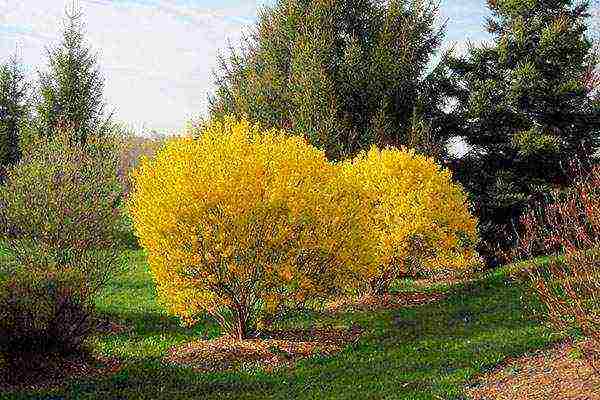 Forsythia is an amazing plant that changes its appearance every season. In the spring, these are branches devoid of leaves, but densely strewn with flowers. In summer, the bush is covered with greenery, which changes color to golden or purple in autumn. When looking for a place for forsythia, you should pay attention to areas where the shrub will be clearly visible and illuminated.
Forsythia is an amazing plant that changes its appearance every season. In the spring, these are branches devoid of leaves, but densely strewn with flowers. In summer, the bush is covered with greenery, which changes color to golden or purple in autumn. When looking for a place for forsythia, you should pay attention to areas where the shrub will be clearly visible and illuminated.
Although forsythia tolerate shade, in the sun the bush forms more dense and even. The plant is undemanding to soil fertility, but it develops better on soil with an alkaline reaction, good drainage. Culture:
- undemanding to care;
- has excellent frost resistance, simplifying the wintering of forsythia in the open field;
- tolerates drought well;
- responds well to haircuts and can be used for growing hedges.
 There are two options for planting forsythia in the ground: in spring and autumn. In the first case, young shrubs immediately begin to grow after acclimatization, giving new shoots. Bushes transferred to the garden in autumn only take root, and begin to grow after wintering.
There are two options for planting forsythia in the ground: in spring and autumn. In the first case, young shrubs immediately begin to grow after acclimatization, giving new shoots. Bushes transferred to the garden in autumn only take root, and begin to grow after wintering.
Timing of planting forsythia in the ground
The time for transferring seedlings to the garden is chosen depending on the region and the quality of the planting material. Many nurseries today offer young plants with a closed root system.Seedlings grown in containers are transplanted together with an earthen clod, so the roots do not suffer, the bush easily and quickly adapts to a new place of residence. And the summer resident is guaranteed easy care for forsythia in the open field after planting, whenever it happens: in spring, summer or autumn.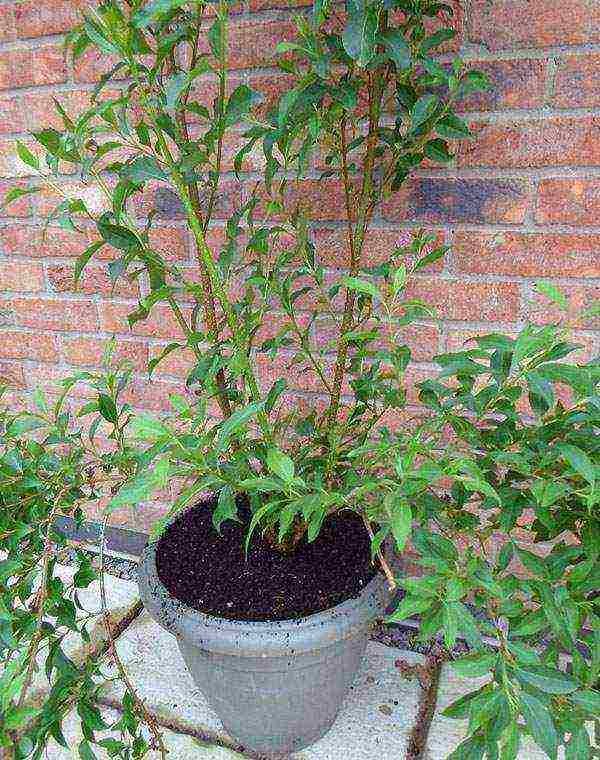
For seedlings with an open root system, it is better to plant in the spring months, when the threat of sudden frosts goes away, or in the fall, about a month before the onset of seasonal cold weather. During this period of time, the shrub will acclimate and be able to prepare for winter.
 Since the climatic conditions in the regions of the country are seriously different, there is a significant difference in the timing of planting and caring for forsythia in the open field, in the Moscow region and, for example, in central and northern Siberia, where the heat comes later, and the summer is much shorter:
Since the climatic conditions in the regions of the country are seriously different, there is a significant difference in the timing of planting and caring for forsythia in the open field, in the Moscow region and, for example, in central and northern Siberia, where the heat comes later, and the summer is much shorter:
- If you delay planting plants in the garden, their adaptation and rooting will be delayed, and the shoots that have dedicated over the summer will not have time to get stronger before the onset of frost.
- Early spring planting threatens with the danger of freezing of the buds, tops of the shoots, and with severe frosts on the soil, damage to the points of growth and roots.
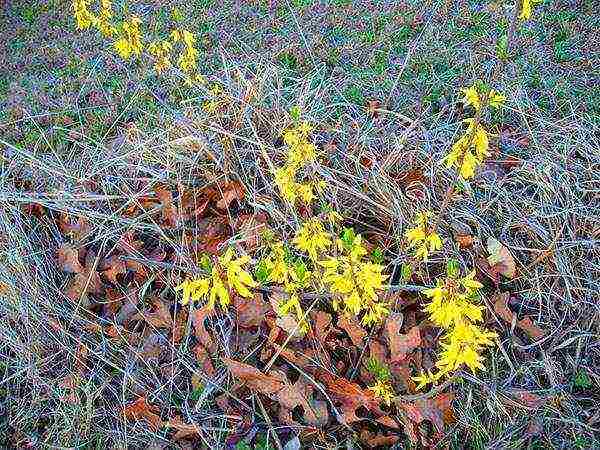 In autumn, planting forsythia in the ground also depends on weather and climatic conditions and can vary even within the same region, for example, as large as the Urals. If in the south gardeners live according to a calendar similar to that used by summer residents of the middle lane, then in the north the weather is much more severe and changeable.
In autumn, planting forsythia in the ground also depends on weather and climatic conditions and can vary even within the same region, for example, as large as the Urals. If in the south gardeners live according to a calendar similar to that used by summer residents of the middle lane, then in the north the weather is much more severe and changeable.
Planting forsythia in open ground
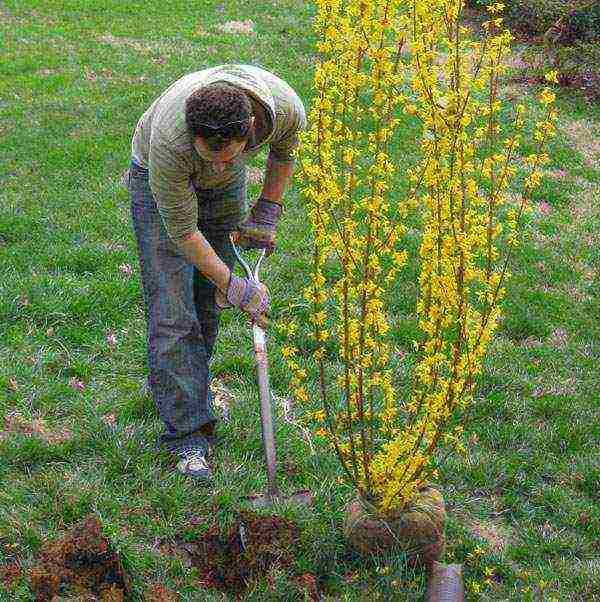 Forsythia prefer dry, drained soil and do not tolerate stagnant moisture in the soil. Therefore, at the bottom of the planting pits 60 cm deep and 50 cm wide, powerful drainage is made from broken brick, expanded clay or gravel. It is especially important not to neglect this measure in areas with dense soil that retains water and where groundwater is too close. An example is planting and caring for forsythia in the Leningrad region.
Forsythia prefer dry, drained soil and do not tolerate stagnant moisture in the soil. Therefore, at the bottom of the planting pits 60 cm deep and 50 cm wide, powerful drainage is made from broken brick, expanded clay or gravel. It is especially important not to neglect this measure in areas with dense soil that retains water and where groundwater is too close. An example is planting and caring for forsythia in the Leningrad region.
A layer of sand and a previously prepared soil mixture are poured over the drainage on the basis of:
- 2 pieces of leafy land;
- 1 part peat;
- 1 part sand.
 For each hole, 200 grams of sifted wood ash is mixed into the ground. The substrate is poured with a mound, on the sides of which the roots of the bush are spread. After filling the hole, the soil is compacted and watered abundantly at the rate of 10-15 liters per plant. In the fall, after planting forsythia, caring for the shrub consists in dense mulching of the trunk circle. This will help conserve water in the soil and protect the roots from hypothermia.
For each hole, 200 grams of sifted wood ash is mixed into the ground. The substrate is poured with a mound, on the sides of which the roots of the bush are spread. After filling the hole, the soil is compacted and watered abundantly at the rate of 10-15 liters per plant. In the fall, after planting forsythia, caring for the shrub consists in dense mulching of the trunk circle. This will help conserve water in the soil and protect the roots from hypothermia.
Mulch will help in spring, especially where summer comes quickly and the soil dries quickly, covered with a dense, impenetrable crust.
Caring for forsythia after planting in the open field
 An important advantage of forsythia is its simplicity and the absence of any special care. In the warm season, shrubs that grow rapidly with minimal care need:
An important advantage of forsythia is its simplicity and the absence of any special care. In the warm season, shrubs that grow rapidly with minimal care need:
- in irrigation, if there is no natural precipitation, and the soil under the plants is completely dry;
- in maintaining the cleanliness and looseness of the trunk circles;
- in a triple feeding;
- in a haircut that helps maintain the health and shape of the crown.
In hot dry times, the plants are watered abundantly once or twice a month, the field of which is loosened, weeded and mulched. Lowland peat mixed with humus and wood ash can be used as mulch. This composition protects the roots from overheating and is an excellent long-acting fertilizer. In addition, shrubs respond well to full fertilization before and after flowering.
In the second half of summer, you should not fertilize shrubs with nitrogen. It will cause active growth of young shoots, which, even with proper planting and caring for forsythia in the Urals, Siberia and in the middle lane, will not have time to ripen and will die with the onset of frost.
An important part of caring for forsythia is pruning the shrub.For sanitary purposes, the removal of dead, old or damaged branches is carried out in the spring, and a haircut to maintain shape - in early summer, when the mass flowering ends. Until recently, shoots yellow from flowers can be shortened by half the length, and old branches are cut above the ground so that several buds remain at the base.
Once every 3-4 years, forsythia is rejuvenated by evenly cutting all shoots by half or two-thirds of the length. Over the summer, the plant will restore the crown, which will be dense, uniform and young, so that next spring it will please with a friendly bright flowering.
In most regions, the plant winters excellently without shelter. If the winters have little snow, before wintering, forsythia in the open field is gently tilted to the ground, fixed and covered with spruce branches or dense non-woven material. At the first opportunity, the bushes are covered with snow.
Reproduction of forsythia in the open field
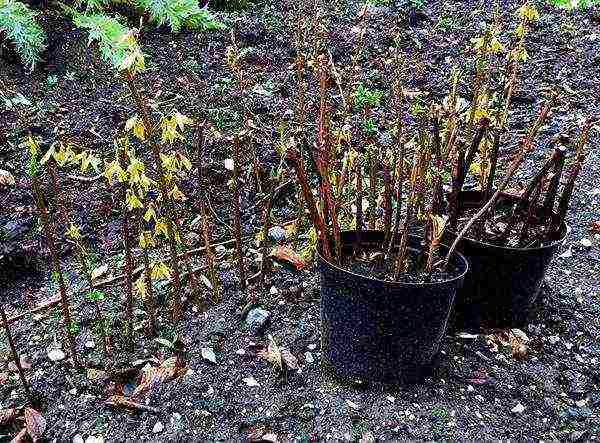 The remaining parts of the branches after pruning are an excellent material for obtaining cuttings that will serve for the propagation of forsythia. The green shoots are cut into pieces 10-15 cm long so that each one has several healthy buds. The lower leaves are cut off, and the resulting stalk, after treatment with a rooting stimulant, is planted in a greenhouse.
The remaining parts of the branches after pruning are an excellent material for obtaining cuttings that will serve for the propagation of forsythia. The green shoots are cut into pieces 10-15 cm long so that each one has several healthy buds. The lower leaves are cut off, and the resulting stalk, after treatment with a rooting stimulant, is planted in a greenhouse.
 In the fall, another method for breeding forsythia in the open field is possible. Lignified cuttings are planted in a school organized in a quiet place protected from wind and flooding. For the time remaining before the cold weather, the seedling will give roots, and 2-3 buds left above the surface of the soil will wake up in the spring and form a young crown of a dwarf shrub. In the coming fall, such plants can be planted in a permanent place.
In the fall, another method for breeding forsythia in the open field is possible. Lignified cuttings are planted in a school organized in a quiet place protected from wind and flooding. For the time remaining before the cold weather, the seedling will give roots, and 2-3 buds left above the surface of the soil will wake up in the spring and form a young crown of a dwarf shrub. In the coming fall, such plants can be planted in a permanent place.
Planting forsythia in a permanent place - video
In the landscape design of yards and gardens, a plant such as forsythia is very often used. Planting and caring for him is not particularly difficult. In terms of effectiveness, forsythia is significantly superior to many other decorative crops.
How to choose the right variety
Most often, the following varieties of this plant are grown in the gardens and yards of Russia.
- Average fortification. Planting and caring for this plant is carried out using a very simple technology. This is one of the most unpretentious and spectacular varieties. By and large, it is its undemandingness in combination with high decorative qualities that explains its extraordinary popularity. Such forsythia is used most often in the landscape design of the courtyards of our country. Bushes of medium or, as it is also called, intermediate forsythia can reach a height of 3.5 meters. Their main distinguishing feature is their very spreading straight drooping branches.
- Forsythia is ovoid. This undersized variety is also very often used in landscaping. In height, ovoid forsythia bushes reach about 2 m. The main advantages of this variety include rapid growth, frost and drought resistance.
- Hanging forsythia. This spectacular variety was developed in China. It reaches a height of 3 meters and has a very lush, spreading shape.
In principle, any yellow forsythia, planting and caring for which is carried out according to the technology, which will be discussed by us below, can become a very good decoration of the yard. However, for central Russia, of course, only frost-resistant varieties are mainly suitable.
What should be the planting material
Next, let's see how to choose the right seedlings for a plant like forsythia. Planting and caring for this ornamental crop is technologically very simple procedures. However, much in the success of its cultivation depends on how correctly the planting material will be chosen. It is worth purchasing only seedlings with thick branches and a large number of buds. Do not buy plants with broken twigs or damaged shoots.
How to choose a landing site
A lot of sunshine and warmth is what forsythia loves. Planting and caring for it should be carried out taking into account, among other things, this factor. In the sun, this plant develops and blooms much better. However, in partial shade, this decorative culture also feels good. The best places for forsythia are well protected from the wind. Usually these plants are planted in groups along the fence and paths.
What should be the soil
A nutritious, moisture and breathable soil is most suitable for a plant such as forsythia. Planting and caring for her - operations, as already mentioned, are simple. However, it is better to prepare a special soil mixture for this plant. The soil of the following composition is very good for forsythia: humus, sand, leafy earth in a ratio of 1: 2: 1. This ornamental plant does not like acidic soils. If the soil on the site has a low pH, it must be improved by adding wood ash.
How to plant
The depth and width of the forsythia pit should be about fifty centimeters. In the event that several bushes are planted on the site, the distance between them should be left at least 2 meters. Landing is done like this.
- Drainage is laid at the bottom of the pit with a layer of ten centimeters. It can be broken bricks, rubble, etc.
- 5 cm of coarse sand is poured on top.
- The plant is carefully removed from the container.
- Then it is lowered into the hole so that the root collar remains on the surface.
- The roots are covered with prepared soil mixture.
- The trunk circle is slightly trampled down.
At the final stage, the plant is watered and mulched with humus, straw or fallen leaves.
How to care
Unpretentiousness is what distinguishes almost all varieties of such a plant as forsythia. Planting and care (photos of adult flowering bushes can be seen on this page) are easy to follow. All that the owners of a suburban area will need to do when growing forsythia is:
- water the bushes from time to time;
- loosen and weed the trunk circle;
- pruning bushes.
How to water forsythia
In this regard, the plant is completely undemanding. This is especially true for a variety such as medium yellow forsythia. Planting and caring for her - the procedures are as simple as possible. Many owners of summer cottages do not water such forsythia at all. This decorative culture even tolerates drought very well. However, in hot, windy weather, it is best to moisturize the soil under it from time to time. This is usually done no more than once a month, pouring a bucket of water on one plant. After each watering, the trunk circle is necessarily loosened onto a shovel bayonet and mulched again.
How to feed
In early spring, manure should be scattered around each plant. In the future, it will serve as both mulch and top dressing. Also in April, forsythia can be fertilized with a full mineral fertilizer in the amount of 70 grams. The second top dressing is done after the bushes have faded. In this case, the "Kemira Universal" agent is usually used according to the instructions.
How to do pruning correctly
This is how you should take care of such a plant as forsythia. Planting and care, pruning and disease prevention - all this is done according to certain simple rules. Now you know how to water and feed this plant. Next, let's figure out how to shape its crown. Pruning should be done without fail, otherwise the bushes will not look too neat. However, this procedure must be performed with utmost care. For the first few years after planting, forsythia are not pruned. If necessary, only remove frozen branches.
Actually, they begin to form the crown only for 3-4 years. In the spring, the frozen ends of the branches are removed from the plant. The main pruning is done in the summer, after the flowering of the bush. The branches during this period should be cut in half.You also need to remove very old and dried shoots from the bush, leaving stumps about 6 cm high. In the future, new shoots will go from them. When pruning branches, forsythia are usually cupped or spherical.
In hedges, plants should be periodically rejuvenated. For this, the branches are cut by 2/3 or generally "on a stump". After this procedure, a large number of new young shoots begin to grow in forsythia.
Pruning of this decorative culture is done no more than once every 3-4 years. Otherwise, the shoots of the plant will begin to stretch too much, and it will bloom poorly.
Infections
Almost the only disease to which this plant is unstable is moniliosis. Very often even such an unpretentious variety as intermediate forsythia becomes infected with it. Planting and caring for this plant, therefore, must be done correctly. First of all, you should not place forsythia in the immediate vicinity of stone fruit trees, which also often suffer from moniliosis. In the fall, all foliage fallen from the bushes must be collected and burned, or at least buried in the ground in the trunk circle.
In case of infection with moniliosis, forsythia leaves are covered with brown spots. Treatment consists in pruning diseased shoots. In order to avoid re-infection of plants, they must be burned. For the prevention of moniliosis, forsythia shoots, among other things, can be sprayed with a 1% solution of Bordeaux liquid before and after flowering.
How to propagate
Breeding forsythia, as well as caring for it, is very easy. This plant is usually propagated by cuttings. You can take them from forsythia during the entire growing season. Cut cuttings are simply stuck into the ground with a slight slope. They take root very easily. The seedlings are transferred to a permanent place in late autumn or early spring.
Thus, we have figured out in all the details how such an ornamental culture as forsythia is grown. Planting and care (the photos clearly demonstrate the beauty of this plant), as you can see, can be carried out after it even by a completely inexperienced summer resident. In any case, this unpretentious, spectacular shrub deserves to be used to decorate yards and gardens as widely as the well-known lilac and hawthorn.
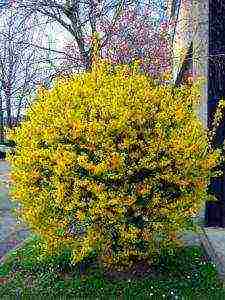 Beautiful bright yellow bell-shaped flowers bloom en masse on bare branches immediately after the snow melts. And only at the end of flowering foliage blooms and the growth of shoots begins, which will delight the eye with yellow abundance in the following spring. Forsythia European or Forsythia, planting and caring for which is quite simple, has a habitat in Albania and in the territory of the former Yugoslavia. Other species were chosen by Japan, Korea and China.
Beautiful bright yellow bell-shaped flowers bloom en masse on bare branches immediately after the snow melts. And only at the end of flowering foliage blooms and the growth of shoots begins, which will delight the eye with yellow abundance in the following spring. Forsythia European or Forsythia, planting and caring for which is quite simple, has a habitat in Albania and in the territory of the former Yugoslavia. Other species were chosen by Japan, Korea and China.
Description
Shrub up to 2 m in diameter and no more than 3 m in height belongs to the olive family. Introduced to Europe from China by William Forsyth, Scottish botanist and member of the Royal Horticultural Society.
A plant with a gray-brownish bark and simple oval leaves 4 to 13 cm long. The fruit is a capsule, pollinated by insects. Forsythia is completely undemanding and feels good in a shaded and sunny place. The main condition is growing on permeable soils. When the plant has faded, it is heavily pruned so that it does not grow much. Reproduction takes place by seeds and cuttings, which are taken during the growing season. Forsythia is not susceptible to diseases and pests. Some of its species are cold-hardy and cultivated in the middle of the country, although in severe winters, the buds can freeze out. Weeping Forsythia in China is considered one of the 50 main medicinal plants.
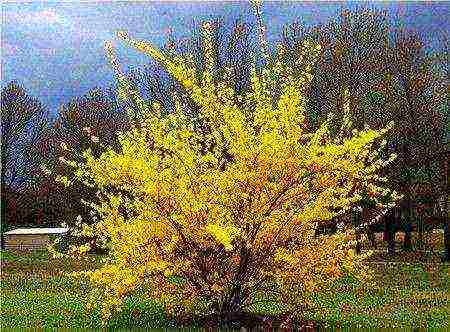
Forsythy planting and care
Vegetative propagation
Forsythia can be propagated:
- Seeds.
- Layers.
- Cuttings.
Cuttings are cooked in winter and kept moist in a cold place at a temperature of +2 degrees.Summer cuttings are carried out in late June - early July. For this, shoots of the first year are selected. Cuttings are cut with one or two internodes with an indent from them by 1 cm. The upper leaves are shortened by half, and the lower ones are cut off completely.
For rapid rooting, the prepared planting material is placed in a heteroauxin solution for 4-5 hours.
Then the cuttings are buried 3-4 cm in wet sand and covered with foil. They need to be planted at a distance of more than 5 cm. In hot weather, watering is carried out 4-5 times a day, in cool weather two times are enough. Roots are formed by the end of the fifth week. By winter, the soil under the cuttings is mulched with a thick layer (15 cm) of dry foliage. The next year, they can be planted in a garden bed, and they are placed in a permanent place only for 3-4 years, where they bloom.
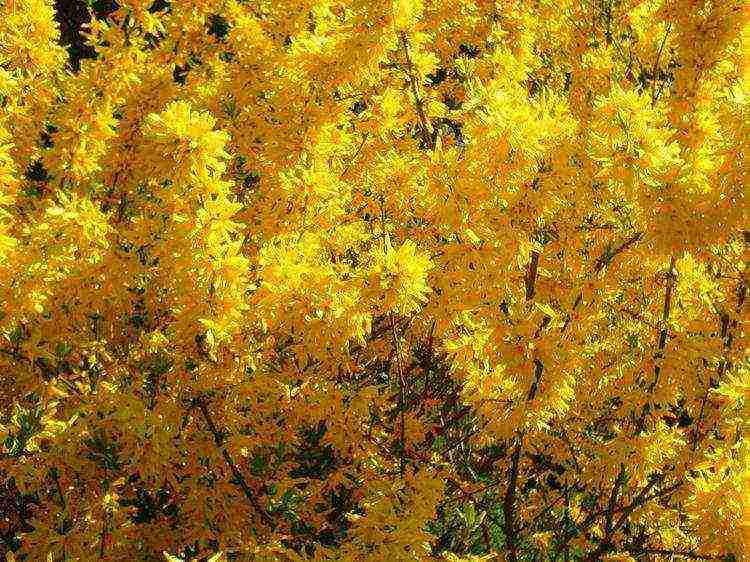
Intense yellow forsythia
The easiest way to reproduce is layering. For this, only weeping forsythia species are suitable. To do this, in the fall, the lower shoots are bent to the ground, the bark is slightly incised at the place of formation of future roots, they are pinned and added with fertile soil by 10-12 cm. In the spring they are cut off from the mother bush and in the fall they are planted in a permanent place. Within a year, the young plant will bloom.
How and when to sow seeds
At the end of autumn, the capsule fruits ripen and crack. At this time, lionfish are selected for spring sowing. At the end of March, they are placed in boxes or pots with fertile soil, watered and covered with glass, followed by regular ventilation. Seedlings appear in 4-5 weeks. When they reach a height of 4-5 cm, they dive into a greenhouse or open ground.
Seed germination is 30-40%. The first flowering occurs in the fifth year.
Planting and caring for seedlings
Pits for frosting are made with a size of 65 X 65 cm and a depth of 70 cm. The distance between them should be at least two meters. The drainage is a quarter of the depth and consists of broken bricks and rubble. Care consists of:
- In rare watering.
- In top dressing.
- In pruning.
- Shelter for the winter
To grow the shrub dynamically, a fertile, moisture-permeable soil mixture is prepared from leafy earth, humus and sand (1: 1: 3) with the addition of phosphorus and potash mineral fertilizers. After planting, the seedlings are watered abundantly. In the fall, preparation for winter is mandatory, which boils down to covering with foliage and spruce branches.
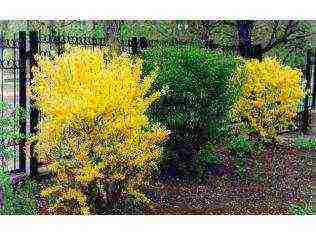
Forsythia bushes
In spring, the plant is freed from the mulch layer and branches. If forsythia was planted in the fall, then no fertilization is applied in the first year.
During the growing season, rare watering is carried out only in dry times (once a month - a bucket of water), since it does not tolerate waterlogging at all.
Starting from the second or third year, when the plant has entered the time of flowering, they begin to feed - 70 g of complex mineral fertilizers per square meter of the trunk circle are applied in spring and autumn. The land under the bush is mulched with humus.
Proper cultivation of forsythia and its abundant flowering is impossible without annual pruning. Young growth is only slightly shortened. In the spring, remove all dry branches, cut off frozen shoots to healthy wood and knock out from the general contour. After flowering, which lasts 20-25 days, the shoots are slightly shortened to make them more decorative.
Types of forsythia
- Giralda.
- Ovate.
- Greenest.
- Hanging.
- Average.
Giralda is originally from the north of China, outwardly similar to the European one. The leaves are serrated, oval, pale below and glossy dark green above. The abundance of medium-sized yellow flowers almost completely hides the shoots. Hardy enough.
Ovate forsythia grows in Korea and reaches a height of one and a half meters. Green glossy oval leaves, up to seven centimeters long. The flowers are bright yellow with elongated petals. The cultivation of the species is possible in the regions of the Non-Black Earth Region.
Hanging forsythia grows up to a height of three meters, the distribution area in nature is the north and central part of China.One of the most beautiful species, for which it is highly valued by Europeans. Can be bred on the territory of Crimea, Moldova, Caucasus. The foliage that is green in summer turns yellow and purple in the fall. Golden flowers (up to six in a bunch) have orange corolla tubes.
The greenest forsythia is a large plant with upright branches. Grows on the mountain slopes of China. The leaves are large, dark green. Flowers up to 3 cm long, yellow-green. On the territory of Russia, cultivation is possible only in the southern regions.
Medium or intermediate forsythia is a hybrid form of drooping and greenish. Straight, slightly drooping branches are very decorative. In early summer, they are covered with golden flowers, then green leaves appear, which do not lose their color by autumn and fall off by November. The garden hybrid has many forms that are quite cold-resistant and suitable for growing in the Non-Black Earth Region.
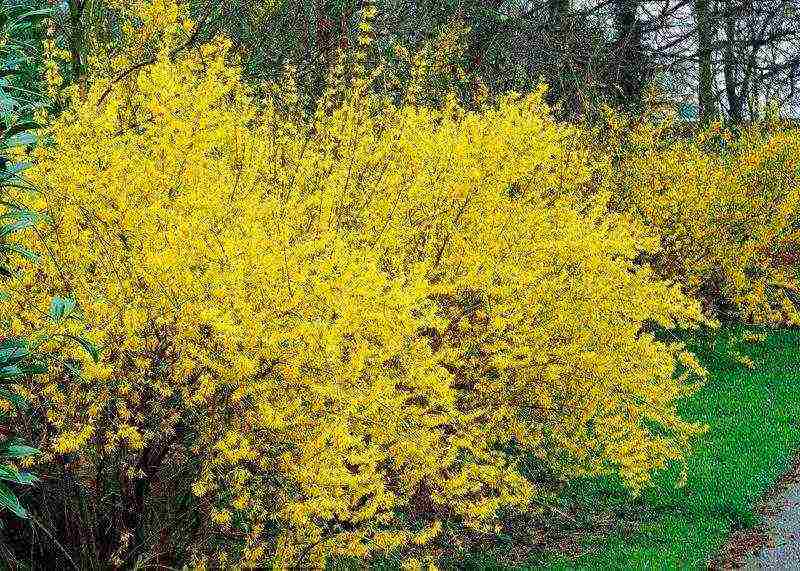
Forsythy planting and care
Landscape application
If properly cared for, forsythia will delight with lush flowering, which begins very early - at the same time as muscari. The combination of yellow and blue looks very advantageous against the backdrop of green lawn. The bushes can be planted as hedges or in large alpine slides. Solitary, golden-blooming shrubs with blue or dark green spruces and junipers are an impressive sight.
Proper care for forsythia (video)


